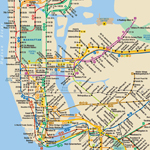
The Subway Shuffle Redux
Last week was a big week for me. I left my sublet and moved into my very own New York apartment! Even though my new home is not that far from the apartment I was renting, I have to find a new grocery store, a new dry cleaner, a new pharmacy. I also have to figure out how to get to work. I used to live on an express stop on the subway, whereas now I am on the local train. Do I walk down to the express stop? Do I take the local and change trains? Do I ride the local all the way? And most important of all: How long does each of these options take?
As I puzzled over the train schedules, I came across this video from the New York Times: The Subway Shuffle
I had to laugh. Ruefully. There is something undeniably funny about the New Yorkers rushing from platform to platform, trying to shave off a few seconds here and there. (And to be honest, when I lived in California, I used to shift from lane to lane, trying to advance a few yards on the freeway.)
But the truth is that there is a cost to rushing all the time.
 The cost is both inner and outer. The inner cost is that when we hurry, we often fail to notice the truth of experience. Rabbi Kalonymus Kalman Shapira described in his book Conscious Community how important it is to learn how to observe our own inner life because it opens us to being able to sense even more. He said, “Perhaps in your looking you will uncover God’s subtle presence; you may sense God’s holiness.” How do we do that? His answer: “You must clearly, consistently and diligently slow down.” (And he wrote that over 70 years ago!)
The cost is both inner and outer. The inner cost is that when we hurry, we often fail to notice the truth of experience. Rabbi Kalonymus Kalman Shapira described in his book Conscious Community how important it is to learn how to observe our own inner life because it opens us to being able to sense even more. He said, “Perhaps in your looking you will uncover God’s subtle presence; you may sense God’s holiness.” How do we do that? His answer: “You must clearly, consistently and diligently slow down.” (And he wrote that over 70 years ago!)
And the outer cost is that when we hurry, we often fail to notice the truth of other people’s experiences. The famous “Good Samaritan experiment” at Princeton showed that the most important factor in determining whether a seminary student would stop to help someone in need was not how much they thought about helping others or the nature of their religious commitment. Instead the main factor was how late the students thought they were. In fact, only 10% of those who were hurrying paused to help a man slumped on the street, as compared to 63% of those who were not in a hurry.
It is so easy to forget and get swept away by the busyness of our culture. It is so important to keep remembering to take our time.

